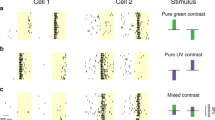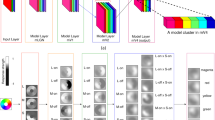Abstract
The ability to distinguish colour from intensity variations is a difficult computational problem for the visual system because each of the three cone photoreceptor types absorb all wavelengths of light, although their peak sensitivities are at relatively short (S cones), medium (M cones), or long (L cones) wavelengths. The first stage in colour processing is the comparison of the outputs of different cone types by spectrally opponent neurons in the retina and upstream in the lateral geniculate nucleus1,2,3. Some neurons receive opponent inputs from L and M cones, whereas others receive input from S cones opposed by combined signals from L and M cones. Here we report how the outputs of the L/M- and S-opponent geniculate cell types are combined in time at the next stage of colour processing, in the macaque primary visual cortex (V1). Some V1 neurons respond to a single chromatic region, with either a short (68–95 ms) or a longer (96–135 ms) latency, whereas others respond to two chromatic regions with a difference in latency of 20–30 ms. Across all types, short latency responses are mostly evoked by L/M-opponent inputs whereas longer latency responses are evoked mostly by S-opponent inputs. Furthermore, neurons with late S-cone inputs exhibit dynamic changes in the sharpness of their chromatic tuning over time. We propose that the sparse, S-opponent signal in the lateral geniculate nucleus is amplified in area V1, possibly through recurrent excitatory networks. This results in a delayed, sluggish cortical S-cone signal which is then integrated with L/M-opponent signals to rotate the lateral geniculate nucleus chromatic axes4,5.
This is a preview of subscription content, access via your institution
Access options
Subscribe to this journal
Receive 51 print issues and online access
$199.00 per year
only $3.90 per issue
Buy this article
- Purchase on Springer Link
- Instant access to full article PDF
Prices may be subject to local taxes which are calculated during checkout



Similar content being viewed by others
References
De Valois, R. L. et al. Analysis of response patterns of LGN cells. J. Opt. Soc. Am. 56, 966–977 (1966).
Lennie, P. & D'Zmura, M. Mechanisms of color vision. CRC Crit. Rev. Neurobiol. 3, 333–400 (1988).
Dacey, D. Circuitry for color coding in the primate retina. Proc. Natl Acad. Sci. USA 93, 582–585 (1996).
Lennie, P. et al. Chromatic mechanisms in striate cortex of macaque. J. Neurosci. 10, 649–669 (1990).
De Valois, R. L. & De Valois, K. K. Amulti stage color model. Vision Res. 33, 1053–1065 (1993).
Hartline, H. K. The receptive fields of optic nerve fibers. Am. J. Physiol. 130, 690–699 (1940).
MacLeod, D. I. A. & Boynton, R. M. Chromaticity diagram showing cone excitation by stimuli of equal luminance. J. Opt. Soc. Am. 69, 1183–1186 (1979).
Derrington, A. M. et al. Chromatic mechanisms in the lateral geniculate nucleus of macaque. J.Physiol. (Lond.) 357, 241–265 (1984).
de Boer, E. & Kuyper, P. Triggered correlation. IEEE Trans. Biomed. Eng. 15, 169–179 (1968).
Ringach, D. L. et al. Dynamics of orientation tuning in macaque primary visual cortex. Nature 387, 281–284 (1997).
Reid, R. C. et al. The use of m-sequences in the analysis of visual neurons: linear receptive field properties. Vis. Neurosci. 14, 1015–1027 (1997).
Stockman, A. et al. The temporal properties of the human short-wave photoreceptors and their associated pathways. Vision Res. 31, 189–208 (1991).
Gegenfurtner, K. R. & Hawken, M. J. Temporal and chromatic properties of motion mechanisms. Vision Res. 35, 1547–1563 (1995).
Rabin, J. et al. Visual evoked potentials in three-dimemsional color space: correlates of spatio-chromatic processing. Vision Res. 34, 2657–2671 (1994).
Dacey, D. M. & Lee, B. B. The ‘blue-on’ opponent pathways in primate retina originates from a distinct bistratified ganglion cell. Nature 367, 731–735 (1994).
Martin, P. R. et al. Evidence that blue-on cells are part of the third geniculocortical pathway in primates. Eur. J. Neurosci. 9, 1536–1541 (1997).
Gielen, C. C. A. M. et al. Reconstruction of cone-system contributions to responses of colour-opponent neurones in monkey lateral geniculate. Biol. Cybern. 44, 211–221 (1982).
Tolhurst, D. J. & Heeger, D. J. Comparison of contrast-normalization and threshold models of the responses of simple cells in cat striate cortex. Vis. Neurosci. 14, 293–309 (1997).
Albrecht, D. G. & Geisler, W. S. Motion selectivity and the contrast-response function of simple cells in the visual cortex. Vision Res. 7, 531–546 (1991).
McCormick, D. A. et al. Comparative electrophysiology of pyramidal and sparsely spiny stellate nuerons of the neocortex. J. Neurophys. 54, 782–806 (1985).
Pugh, M. et al. Computational modeling of orientation tuning dynamics in V1 neurons. Soc. Neurosci. Abstr. 23, 603 (1997).
de Monasterio, F. M. et al. Staining of blue-sensitive cones of the macaque retina by a fluorescent dye. Science 213, 1278–1281 (1981).
Calkins, D. J. et al. Microcircuitry and mosaic of a blue-yellow ganglion cell in the primate retina. J. Neurosci. 18, 3373–3385 (1998).
Malpeli, J. G. & Schiller, P. H. Lack of blue off-center cells in the visual system of the monkey. Brain Res. 141, 385–389 (1978).
Lennie, P. Recent developments in the phsyiology of color vision. Trends Neurosci. 5, 243–248 (1984).
De Valois, R. L. et al. Color appearance with and without S-opponent cells. Vision Res. (submitted).
Hawken, M. J. et al. Laminar organization and contrast sensitivity of direction-selective cells in the striate cortex of the old world monkey. J. Neurosci. 8, 3541–3548 (1988).
Acknowledgements
We thank K. K. De Valois, S. D. Elfar, J. Gallant and E. Switkes for comments on the manuscript, and E. Switkes for implementation of the MBDKL colour space. This work was funded by the NIH.
Author information
Authors and Affiliations
Corresponding author
Rights and permissions
About this article
Cite this article
Cottaris, N., De Valois, R. Temporal dynamics of chromatic tuning in macaque primary visual cortex. Nature 395, 896–900 (1998). https://doi.org/10.1038/27666
Received:
Accepted:
Issue Date:
DOI: https://doi.org/10.1038/27666
This article is cited by
-
Blue-light background impairs visual exogenous attention shift
Scientific Reports (2023)
-
Perception of Color and Its Encoding in the Cortex in Primates
Neuroscience and Behavioral Physiology (2023)
-
Prestimulus oscillatory brain activity interacts with evoked recurrent processing to facilitate conscious visual perception
Scientific Reports (2022)
-
Conducting Channels in the Visual System. The Third Channel
Neuroscience and Behavioral Physiology (2022)
-
A data-driven framework for mapping domains of human neurobiology
Nature Neuroscience (2021)
Comments
By submitting a comment you agree to abide by our Terms and Community Guidelines. If you find something abusive or that does not comply with our terms or guidelines please flag it as inappropriate.



